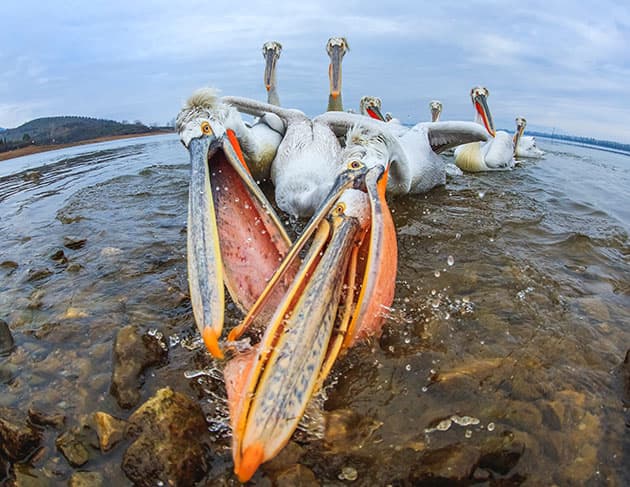The camera slipped out of my hand… my hard drive broke… and it was then I realised all my kit was halfway down the cliff. We’ve all had our share of mishaps and accidents when it comes to taking photographs. What are embarrassing and painful moments at the time soon become amusing and life-learning tales. To help you avoid your own photo disasters we’ve rounded up 24 of our favourite stories from professionals, AP readers, and the AP team. You may laugh or cry (most likely with laughter) but pay attention, as it’s always best to learn from others’ mistakes.
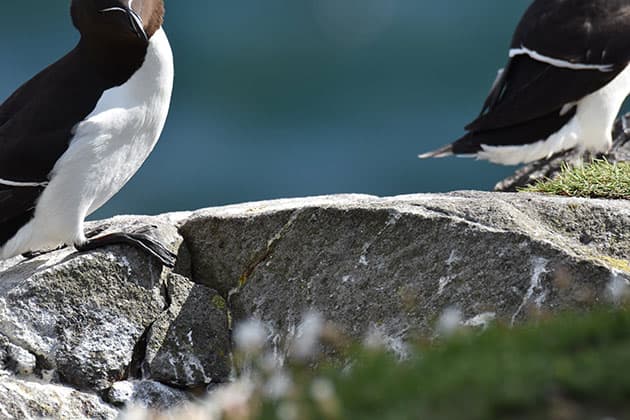
Credit: Claudia Popescu
Wildlife watch – Claudia Popescu
I have desperately wanted to see puffins for the past two years, and when I finally got the chance on the Isle of May, it was extremely windy (extremely is an understatement!). Most of my shots were a disaster.
Rock ‘n’ roll – Dawn Fletcher-Park
When I was photographing Muse at the Glastonbury Festival, the lead singer hurled his guitar in my direction. I was taken completely off guard, and I saw this object come flying towards me. Forgetting that I was seeing it in the zoom lens, I instinctively jerked my head back, only to smack the woman behind me full on in the face with the back of my head, giving her a nosebleed. And I missed the shot.
My pond hell – Andrea Denniss
I fell backwards into a pond – complete with my camera – while teaching a group of photographers. It was the light that did it. It was perfect! I got excited and kept walking backwards to get the right shot. Everything came out covered in pond weed including the camera. I had to borrow clothes from the models (much smaller than me) and my camera continued to work after a brief sit on a radiator. #gocanon
Cut off – Tim Odham
Be very careful you don’t accidentally go into APS-C crop mode on your camera if you are shooting with a full-frame device. It’s annoyingly easy to do this by mistake on the Nikon D750, and an otherwise great image of a Venetian glass blower was ruined as his glass bulb got cropped off.
Don’t get lazy – Norman Kinsella
You have to be really careful about immediately backing up images when shooting weddings and events, however tired you are. I got lazy, and didn’t back up photos of an event immediately afterwards. A few weeks later I tried to copy over to another machine in a rush, and it didn’t work properly. I then shot over the same card and the original images were lost. Often the most dangerous time for a photographer is not when they first start shooting weddings or other events, but after they have been doing it for a while.
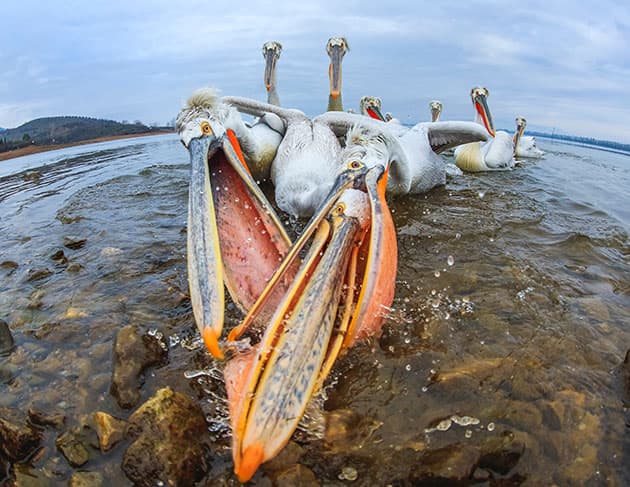
Credit: Caron Steele
Smelly fish – Caron Steele
While photographing pelicans on Lake Kerkini in Greece our guide held a dead fish over my head to try and draw the birds closer. I was then stampeded by pelicans! The lovely guide was also videoing this on my phone. When I stood up to watch the video I stepped backwards and fell into the crate of fish, breaking it and ending up covered in fish and more pelicans. No one wanted to sit next to me on the one-hour journey back to our lodgings.
Tripod basics – Claire Russell
A few years ago, my bestie Marlene Hazlehurst and I found ourselves in Sweden trying to photograph the Northern Lights. Neither of us actually owned a digital camera so we borrowed her husband’s and hired a tripod – it gives you an idea of our level of competence. It was the tripod that fooled us! The legs started to sink into the snow so we bent over further, knelt down, sat down, and ended lying on the snow. It was a pity that no one had explained to us that you can lengthen the tripod’s legs!
Me or the bag? – Annabell Ison
I had to make a choice between me or my camera bag being blown into an 80ft canyon in Iceland. I’m still here but a few of my favourite lenses aren’t. The lovely Joe Cornish came to my rescue to fish my soggy bag and memory cards out of the river. Slightly embarrassing, but a good story later on.
Filter crunch – Verity Milligan
I arrived at a sunrise shoot to find that my Big Stopper had smashed in my bag. I carried on, but somehow didn’t attach my filter ring properly to a new lens I was using. Suddenly the filter ring and the holder/filters/polariser fell off the front of my camera and went straight to the bottom of the Grand Union Canal. About an hour later, I accidentally leaned on my camera bag and somehow smashed my Little Stopper. I drove home very carefully that day. Cursed.
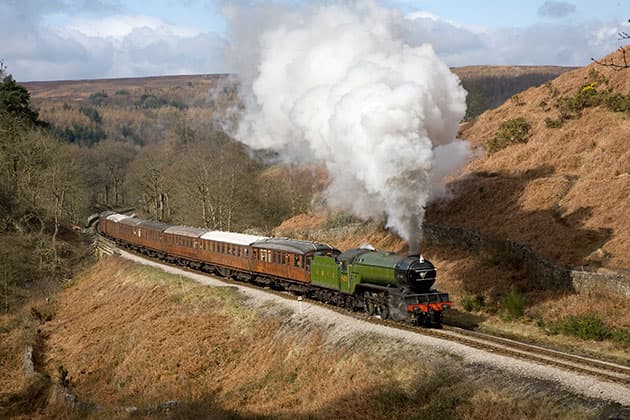
Credit: Mark Hutchinson
Hurry up! Anonymous
I have experienced several disasters in my time as a photographer, some of which I only have myself to blame, and others being accidents that were tricky to avoid. One such disaster that springs to mind occurred ten years ago while pursuing a shot I’d been longing to take at Thomason Foss on the North Yorkshire Moors. After carefully negotiating the narrow footpath that runs high along the top of Thomason Foss Wood, I scrambled my way down to a clearing where you get an excellent view of steam locomotives working hard as they climb up through the valley and past Eller Beck river.
Bracing myself up against a tree and tying myself to it with an outdoor climbing rope to prevent myself slipping down the steep bank and over the cliff edge below seemed like a sensible thing to do after reading about near-death experiences at this risky location in the past. With a few minutes to prepare before the train came along, I set up my tripod in earnest and attached my lens adapter ring ready to accept my LEE Filters holder, which I’d already slotted my favourite 0.6ND grad filter into. In my rush to get set up, the holder didn’t engage correctly with the adapter ring and as I released my right hand, the holder and filter plummeted to the floor. The soft ground cushioned the initial impact, but the way it landed on the steep slope saw it pick up momentum and roll down into the ravine below.
Despite my best efforts of navigating the river later in the day to try and find my missing holder and filter, and getting very wet feet in the process, they were never to be seen again. I learnt my lesson the hard way and although it was a costly mistake to make, it did teach me to slow down and think a little more during the set-up process.
Puffin wee – Tracy Calder
I went on a trip to the Farne Islands a few years ago, and on the boat over I marvelled at the telezooms everyone had on board. I began to worry that my mid-range kit lens would not be enough to get the frame-filling shots I desired. Once on land, however, we all realised that the birds were so close we would probably have been better off with a wideangle lens. As I crouched down to watch a puffin emerge from its burrow the guy next to me removed his telezoom, laid it on the ground and attached a shorter lens. Seconds later I heard a plop and realised it had toppled over into a deep pool of puffin wee. I won’t tell you the language he used, but let’s just say you could probably hear it from the mainland.
The stinger – Linda Ullathorne
I was photographing a friend taking part in the British Pro Cycling race in Ryedale, North Yorkshire. Knowing I had a few minutes to spare before the start I’d settled myself down on the grass with a latte and a big slab of carrot cake on my knee. What could possibly go wrong? All of a sudden as I picked up my camera to remove the cap I felt a sudden stabbing pain in my arm (the saggy, bingo-wing bit) and realised a large wasp was stinging me. My husband jumped into action and ran over to pull it out (leaving the stinger in my arm). I moved back and dropped my camera front first into the buttercream on the cake and spent the next half hour desperately trying to clean my lens (cream just smears and smears) with an arm gradually doubling in size. Moral of the story: eat salad!
New camera – Duncan Eames
I had my new Nikon D810 for three weeks (it had only just been released) and had it set up on my tripod paired with my 500mm f/4 lens. I had the camera and lens perfectly balanced on the tripod head. As I was doing up my camera bag I watched the tripod, in what seemed like slow motion, start to tilt up, making the whole set-up collapse and smash to the ground. I found the camera lens mounting ring still attached to the now-detached lens and the front of the camera a little wider. I travelled for about two hours for the shoot and was heading back home within 15 minutes of arriving. I was gutted that it cost me £450 to repair but grateful that the lens didn’t need to be repaired.
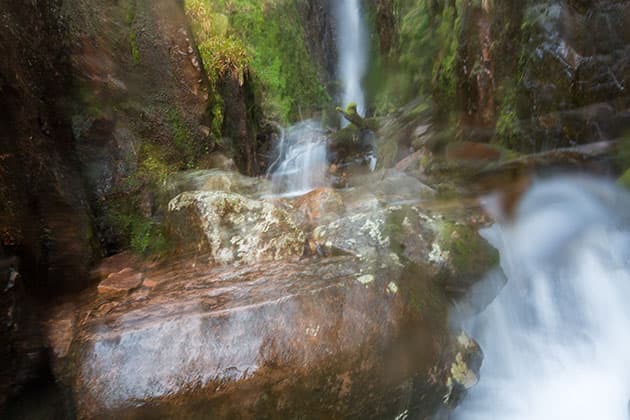
Credit: David Hopkins
The ‘death photo’ – David Hopkins
My traumatic camera disaster occurred a couple of years ago following an excited 90-minute trek through ankle-busting rocks and welly-sucking bogs to the lesser known but highest waterfall in the Lake District, Scale Force. All was going well: the weather was grand, my spirits were high and there wasn’t another soul, let alone another photographer, around. These are the things landscape photographers dream about, pure uninterrupted bliss. I scrambled up three metres of slimy, green, algae-laden wet rocks to get a position at the base of the waterfall. Perfect, there were so many potential compositions; I could easily spend the rest of the afternoon here. Sadly the photography gods were mocking me from afar. They did allow me to squeeze off a couple of keepers just before I did my best Bruce Lee impression – slipping on a wet rock and whipping my back leg from under me; I flying kicked my camera, lens, tripod and filters into the clear waters below.
My final exposure perfectly captured a streaky garbled mess. To make matters worse, not only did I have a depressing hour as I trudged back to my car wet, but I also witnessed the most beautiful sunset I’d ever seen over Crummock Water. Law of sods 1, Dave 0.
Fresh cow pat – Linda Ullathorne
I spent quite a while on a local landscape shoot laid on my stomach in mud only to get up and discover it was actually a very fresh cow pat. I had to walk three miles back absolutely covered in it and surrounded by flies.
Fractured wrist – Mags Hudgell
We were on a photography camping trip in Mull and went out to take early-morning shots on the beach. Wellies and slippery rocks led to a fractured wrist. I was protecting my friend’s lens, which I had borrowed. The lens was fine.
Rescue time – Sharon Thomas
I had to be rescued by a woman in a small rowing boat as the tide came in and cut me off from the mainland along the Norfolk coast. It was so embarrassing hauling my tripod and gear into the boat.
Expensive mistake – Catherine Allen
On Dartmoor I took my LEE Big Stopper off my camera, wrapped it up nicely and put it in my coat pocket. Then I forgot about it. I sat down for a breather on a rock and heard a nasty crunching sound. Expensive mistake.
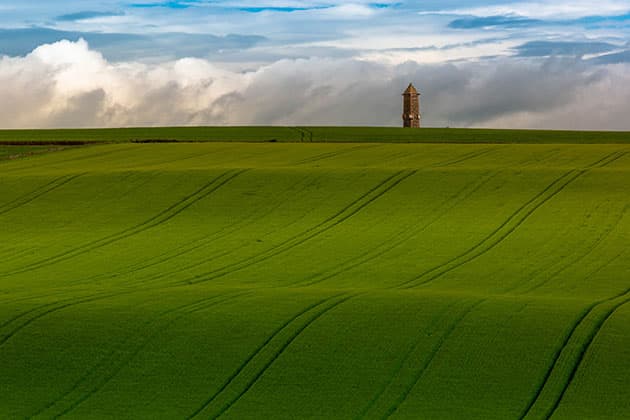
Credit: Derek Coull
A&E time – Derek Coull
I stopped to shoot a landscape and slipped while crossing a barbed-wire fence, embedding my leg in the wire. Once I got my leg free I realised the cut was quite bad because the blood was running down the back of my leg. So I set up the tripod and took the shot as I knew I had to come home with something for my trouble. I took three shots and then promptly headed to A&E. I got the photo though.
Into the mud – Cristina Krippahl
Having to step over some puddles, I handed my camera to my husband to hold while I took a little leap. He dropped it into the mud.
No photos – Fiona Luke
I insisted on taking the photos of my father’s graduation; he got a degree with honours (he was in his mid 60s). After the event I realised I had my finger on the wrong button.
Lost battery – Leanne Hilless
My one and only camera battery fell into the baboon enclosure at Yorkshire Wildlife Park.
Faulty product? – Rach Frith
I bought a new Sigma lens and it wouldn’t focus at a distance. I took it back to the shop and complained that the lens was not working and so on. They then slid the switch across to allow the lens to use its full focal length.
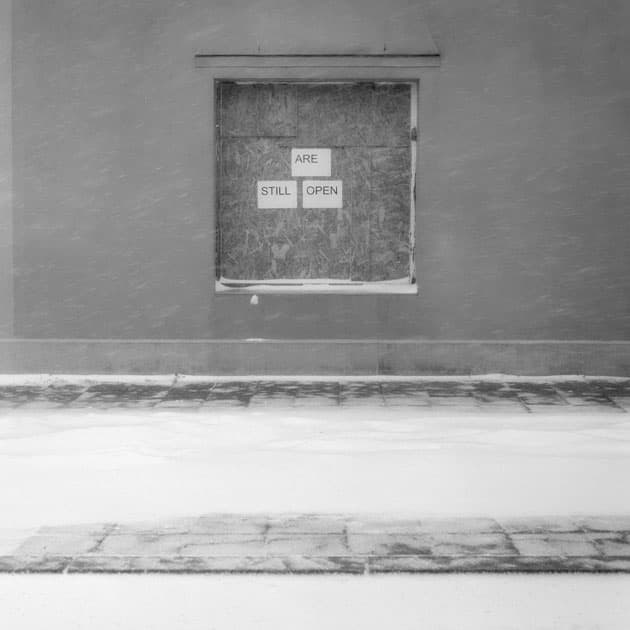
Credit: David Clapp
Storm Emma – David Clapp
I have had my fair share of calculated mishaps in my landscape photography career, but the narrow escape from Storm Emma in March 2018 was a truly memorable one. My good friend Mark and I were having coffees in the Fox Tor Cafe, Dartmoor, wondering whether anything was actually going to happen. Tall stories of an incoming ‘snowmageddon’ seemed highly unlikely and by 2pm there was nothing but a few flakes.
I had taken the decision to shoot the experience on film, using a gold 1970s Mamiya C330s. I took a simple, standard 80mm lens approach, the camera loaded with HP5 and a spare Tri-X in my pocket, both ISO 400 films. Unlike most tourists, I believe Princetown is a particularly interesting place and in the past few years it has really captivated me enough to actually become a project. Its tragic streets are haphazard and creatively heavyweight. The church is bleak. The officer’s mess in the centre of the town, still surrounded with hoardings, sits on a row of closed shops leading to the foggy, oppressive profile of Dartmoor prison. In other words, in its unique way, it’s absolutely magical.
By 3pm, the wind had picked up and the snow started to thicken. We made it down the high street past ‘… are still open’, three desktop-printed words pinned to the hoarding of a closed cafe. Every time I sprung open the Mamiya viewfinder, I laughed as it dilled with snow. This is not going to be easy, I thought. One roll down, I realised there was nowhere to change film, so I knocked on a random door. A smile appeared behind the chain and I soon found myself crouched in a hall, explaining to a mother and her eight-year-old about my unlikely vintage technological complexity.
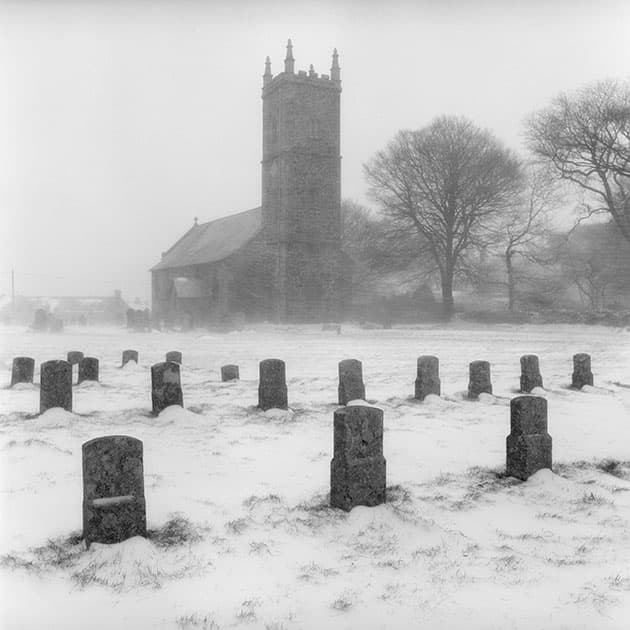
Credit: David Clapp
Heading to the open church door, I was surprised to see the nave was filling with snow. The wind blasting across the graveyard was intense, the camera tripod was becoming unsteady and after a few more shots Mark and I left, knowing the open moors could be significantly worse.
We snapped a snow chain heading north to Moretonhampstead, fixed it with some borrowed pliers and then agreed we stood greater a chance if we headed south to Plymouth. Well that didn’t quite work out. As we reached Burrator, the road was impassable. The wind was blowing so hard my Ford Mondeo was sliding sideways as we reached a snow drift and we saw an abandoned Skoda and a prison van, side on in a ditch.
Two hours later, and an attempt by three 4x4s to pummel their way through had failed and there we all sat, waiting for the sound of a tractor, the fourth emergency service shall we say, to dig out two miles of moorland road single-handed.
We spent the night in Dousland, in the charity of my father-in-law’s church friends, as the wind and freezing rain encased my car in a frozen glass box. The A38 was a graveyard on the way back. The photos were good though.
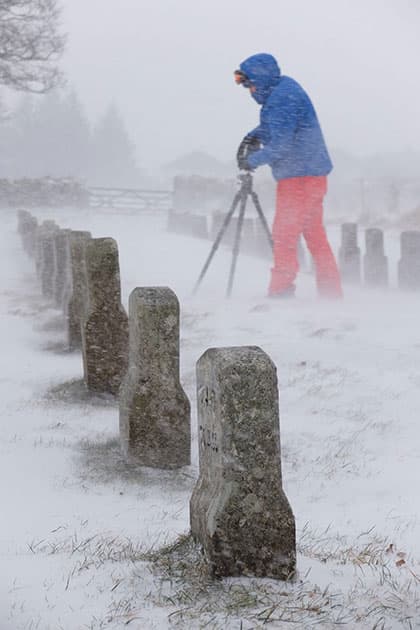
Credit: David Clapp
Top tips to avoid a disaster
- Double back up Back up all your work and then back it up again! Yes it’s tedious and more expensive to do it this way; however you’ll be grateful if your hard drive fails or your computer crashes.
- Wear sensible footwear Slippery rocks, uneven ground. Up your chances of staying upright by wearing sensible shoes that grip.
- Secure your camera bag Lenses falling out and smashing to the ground are things we’ve heard of a lot of times. Spend a moment checking that the zips on your camera bag are secure and making sure everything is back in the right place.
- Tripod maintenance Lots of trust and expensive kit ends up on your tripod. Every couple of months give it a good check over to make sure all the catches are secure.
- Take your time Many accidents happen because you’re in a rush to get the shot. Yes the light is changing quickly, but if you slow down just a tad you’re less likely to damage something in the process.
- Get insurance Sometimes it’s unavoidable and accidents are going to happen. A good insurance policy helps keeps peace of mind.
- Tell someone where you’re heading Landscape photographers, if you’re going out into the back of beyond tell someone where you are heading and what time you expect to be back.
- Check tide times For any coastal shoot, having the tide times to hand is vital. You don’t want to get cut off by the water, which can happen in the blink of an eye if you’re not careful.


